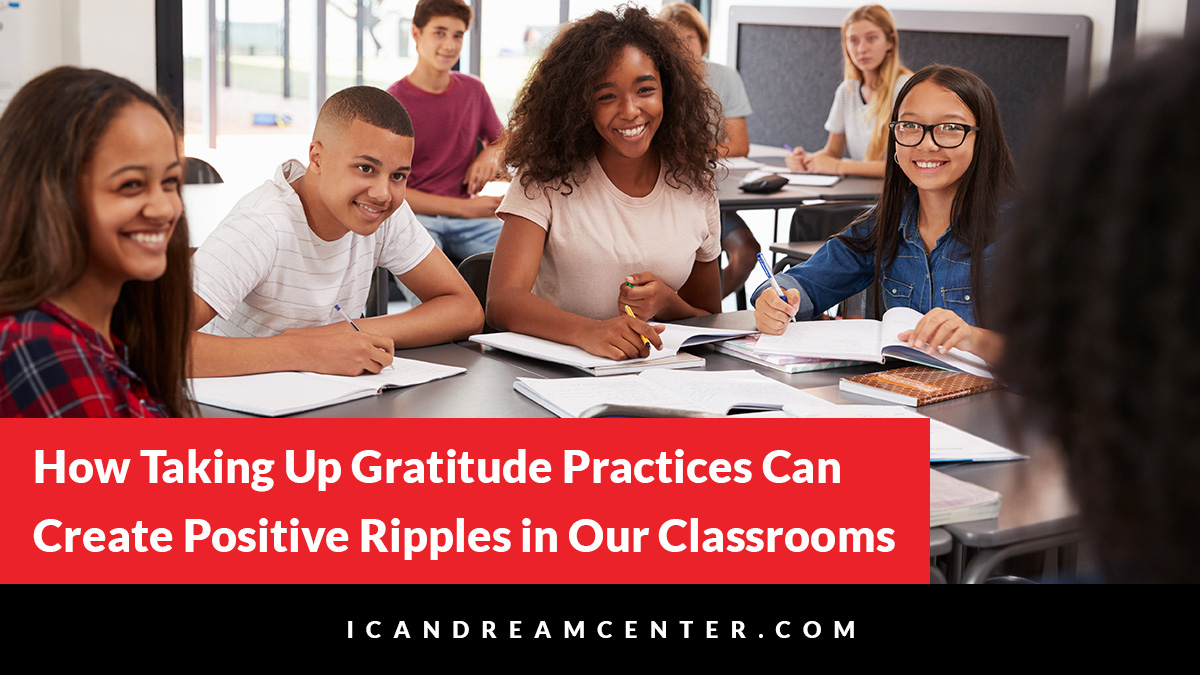
It’s Almost Thanksgiving: How Taking Up Gratitude Practices Can Create Positive Ripples in Our Classrooms
Much research has highlighted the potential of gratitude to enhance well-being, improve relationships, and increase our ability to deal with adversity.
Broadly speaking, we take gratitude to mean an act of giving back out of acknowledgement for what we have received. This need not involve direct reciprocity, though for many cultures it cannot be separated from it. The crux of its effectiveness as an education practice is that gratitude is freely given, without a quid pro quo expectation around it. If a teacher expresses gratitude to a student, it is best not to look to the reaction of the student as a measure of the impact of the gratitude or to expect anything in return.
Although one of the outcomes of being grateful is often reported to be an increased sense of positivity, positivity and gratitude need to be considered as separate constructs. One does not need to be in a positive state to express gratitude or wait until others around them are feeling positive.
The distinction between gratitude as an emotion and gratitude as an action is important in the context of education. Teachers should not think that they need to aim to feel grateful all the time. In fact, just one action we take in a day can have a profound effect on our feelings and on those around us. It is helpful to go even further to construct gratitude actions as practices. The concept of a practice reminds us that we need to be involved in a conscious and purposeful act that we repeat until we have mastered it, rather than leaving it to chance or when we feel like practicing. Considering gratitude as a professional practice allows us to see that we do not need to be perfect all the time, and that gratitude in its complete and most powerful sense is an action of some kind that grows out of our feelings of appreciation or thankfulness.
However, many of us fail, often before we can start to truly express gratitude, especially with difficult students or colleagues. Research shows that when teachers adopt just a few simple gratitude practices that they have not embarked upon before, or in areas where they have had little or no gratitude, they report profound results.
Gratitude practices that they report to be most effective include greeting students, smiling more often, thanking students and colleagues, and teaching with a sense of appreciation for the subject matter and opportunity to teach. These only become gratitude practices when they are done with an ‘inner attitude’ of gratitude, or in other words, where the spirit behind the practice is an acknowledgement of what they receive and what they want to give back.
For example, a teacher may have been greeting students as a habit for many years, but it is not until that teacher does so with an inner attitude of gratitude that it becomes a gratitude practice. As a result of taking up such practices, teachers report that they give greater priority to relationships rather than tasks; develop greater collegiality, feel calmer, have a greater overall sense of well-being, and as an important side effect, their students are more engaged.
Use Gratitude to Recognize Students and Colleagues
These outcomes can be explained by the power gratitude has to bring about a giving and receiving relationship and to thereby move past the functional or ‘exchange’ relationships that many find themselves in because of increased emphasis on performance and tasks. Indeed gratitude cannot exist without a relationship because it calls upon us to give back to another. It also strengthens a relationship by recognizing what we receive from another person. If a teacher greets their students with an inner attitude of gratitude, for example, they are recognizing them in a particular way, and this brings about a stronger connection. Often students need such recognition to feel that they belong, and to be able to orientate themselves to where they feel trust and warmth. The same can be said of expressing gratitude to one’s colleagues.
To recognize others in ways that they can genuinely feel our gratitude, we need to take time to reflect on what we receive and give back in ways that are culturally appropriate and meaningful to that person. Recognizing a student publicly in class by thanking them for what you have noticed and appreciated in their efforts may be boosting for one student but doing so with another from a different culture may generate embarrassment. Our focus on gratitude therefore stretches our interpersonal attributes because it calls upon us to come to know others in ways we may not have given any attention to in the past.
Choose Gratitude Rather Than Resentment
There is an important symmetrical relationship between resentment and gratitude, where they are at opposite ends of a spectrum. In other words, where there is gratitude there can be no resentment and where there is resentment, gratitude cannot exist. They cancel each other out. Our expressions of gratitude unite us with others and encourage us to recognize, celebrate difference, and acknowledge the efforts of others. Resentment on the other hand leads us to reject, divide, ignore, lament, blame, backbite and criticize. When teaching in environments where there is low morale and diminished trust, it is helpful to choose gratitude as the point on the compass to help us navigate how we want to respond. This does not mean that we simply replace resentment with gratitude, as this may lead to putting a positive veneer over negative situations that are crying out for our attention. Rather, a powerful and effective gratitude practice is to take one step out of resentment by naming it or acting on it in some way by addressing the cause directly with the person or dealing with the resentment in a proactive way. Another practice might be to start our day with an inner attitude of gratitude rather than resentment and to reflect on this as we drive to work or as we are about to enter our classroom.
Practice Gratitude During Adversity
Empirical research in positive psychology shows that those who are in a more grateful state are more optimistic, have greater resilience, tend to get less depressed, and have enhanced wellbeing. However, it may be difficult to practice gratitude when we are feeling stressed, or hurt, or going through areas of personal hardship. It may be almost impossible to express gratitude towards someone who has caused us pain. It is important not to set ourselves too lofty a goal and then feel disappointed in ourselves if we cannot practice, contributing to even greater negativity. An effective gratitude practice at these times is to choose an area where it is easy to feel grateful and think of one way in which to express it. If a teacher is feeling angry because of the behavior of a particular colleague, they could focus on feeling grateful for the ability to teach and express this to their students by thanking them when next in their classroom. Such actions not only move that teacher into a more resilient state by bringing more gratitude into play, but also enables them to turn their attention and energies toward a more positive direction. Although the research on gratitude points to many potential benefits for teachers, it is important to contextualize gratitude within the complexities it can often raise, and the different cultural connotations and emphasis given to this giant of a concept when it is considered in an education context. As Johannes Gaertner wrote, “To speak gratitude is courteous and pleasant, to enact gratitude is generous and noble, but to live gratitude is to touch heaven.”
You may already recognize teachers in your school who live with gratitude and note that their classrooms are ‘heavenly.’ Interestingly, the story behind their gratitude is often one of great adversity they have had to face. For most of us, the journey to living gratitude needs to be one of first taking up gratitude practices and then noticing the many ripple effects within and without.
